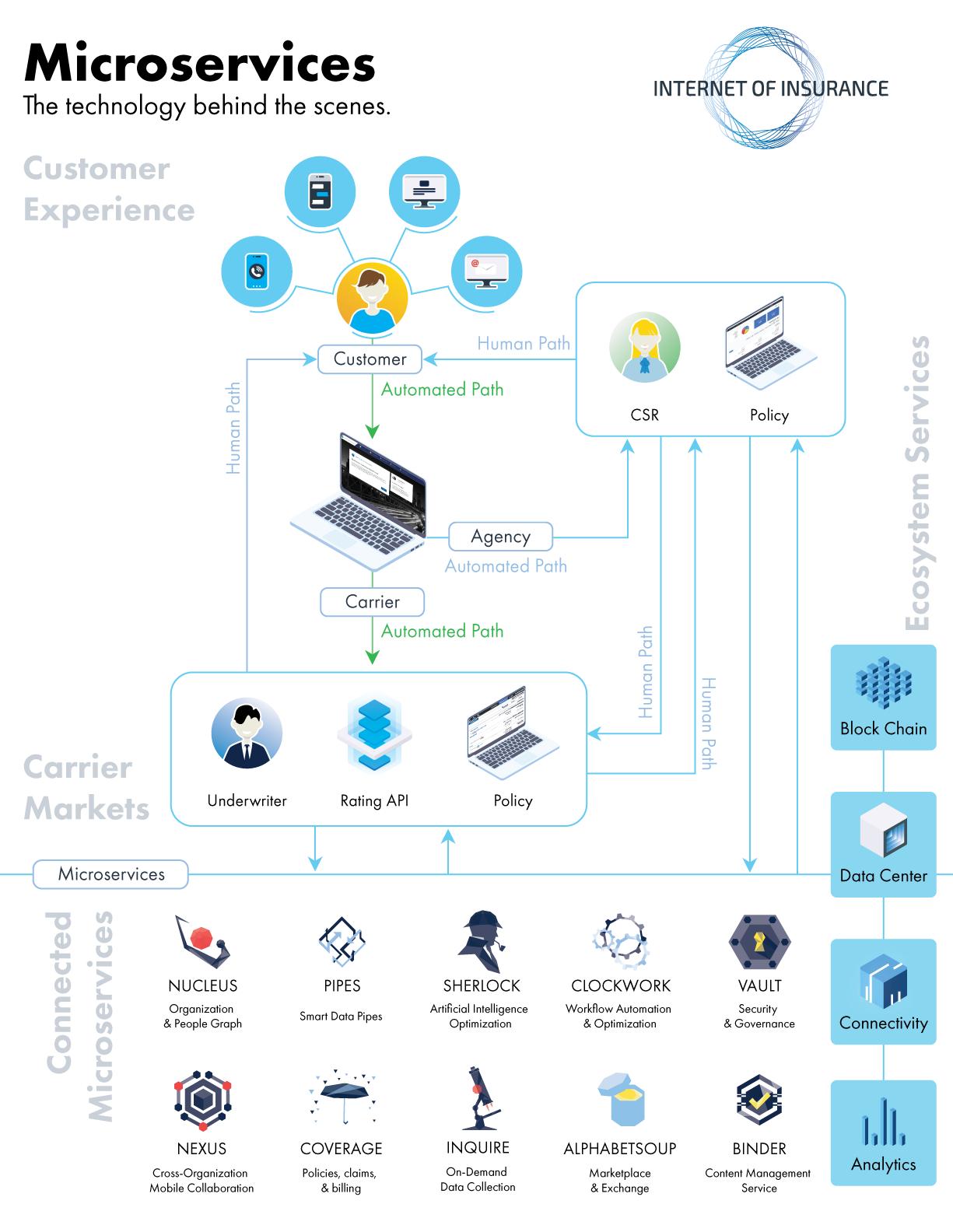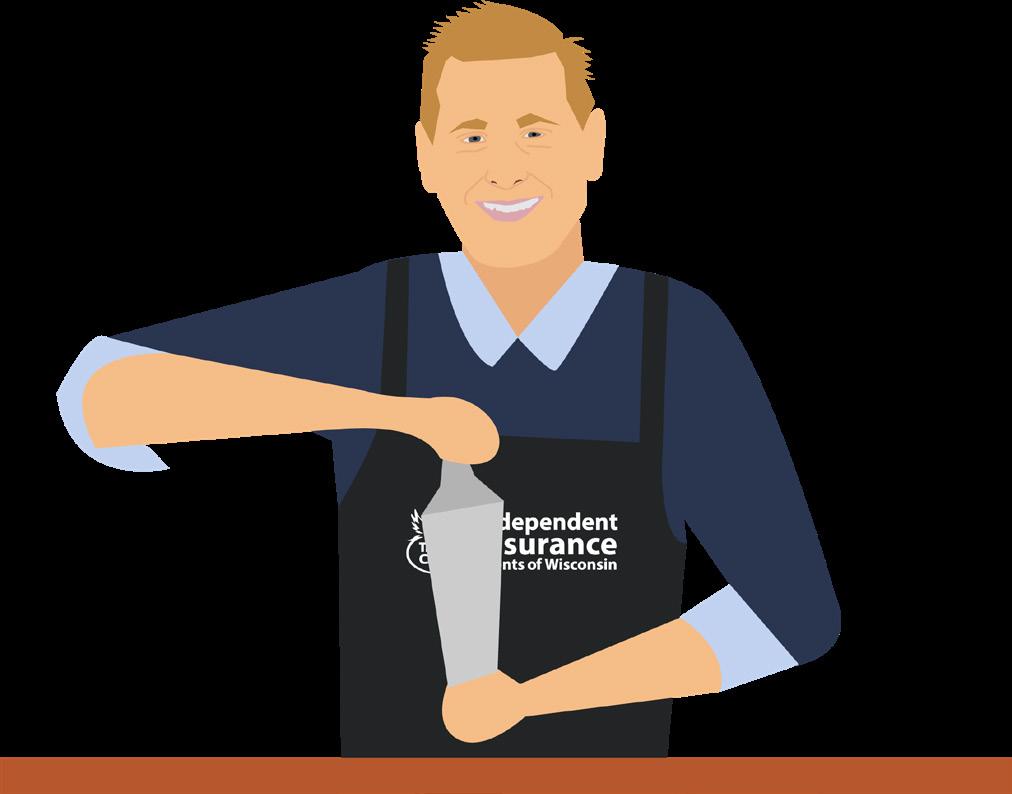
8 minute read
Insurance Bartender: Microservices: The Architecture Behind the Internet of Insurance and Small Commercial Portal
What do Uber, Netflix, Ebay, Amazon, Etsy and Coca Cola all have in common?
Advertisement
In my article titled, “The Rise of the Digital Ecosystems and the Internet of Insurance” I wrote about how these companies have transformed themselves by developing and deploying a microservices based platform. That article focused more on platforms and ecosystems and not the underlying technology or microservices that is powering it all.
Microservices are an architectural approach to building applications. Before we get into why microservices are important and relevant to the insurance industry, we must first understand what an application is.
A simple Google search will tell you that, an application, also referred to as an “application program” or “application software”, is a computer software package that performs a specific function directly for an end user or, in some cases, for another application. An application can be self-contained, or it can be run as part of a group of programs (Microsoft Word and Microsoft Office, for example).
All you really need to understand is that an example of a traditional application program/ software is an insurance agency’s management system or accounting software such as QuickBooks.
According to Jason Kolb, CEO & CTO at Dais and the Internet of Insurance, “Microservices represent a different approach to the way that large, complex software is built. You can think of microservices as building blocks, each with its own unique purpose, that can be combined in different ways to create larger, more complex applications. They’re typically separate projects within the codebase which means that teams can work on them independently and much more quickly. And the different microservices within an application talk to each other by means of API’s (Application Programming
Interfaces). At the end of the day it’s a modular approach to software development that encourages reuse and speed, as well as the ability to swap out components as they become outdated.”
Microservices architecture has become more popular to increase scale, speed of change, ease of integration and ability to adapt to changing business demands and models. Amazon, Netflix, PayPal, eBay, Twitter and Uber, have all built and scaled their platforms based on microservices architecture. It continues to be widely adopted and expanded across various industries including insurance. However, this change is not being driven by traditional insurance technology vendors like Applied, Duck Creek, Vertafore and others you would come to expect, but by companies such as Dais and the Internet of Insurance.
Whether it’s on the carrier or agency side of technology, the industry has been haunted by complex monolithic applications or as we like to call them, legacy systems. These are the applications you’re probably familiar with such as policy management systems, claims systems, billing systems and agency management systems. These legacy applications are typically tightly integrated with and dependent on one another and must be deployed, upgraded and replaced simultaneously as a large monolith application. Therefore, when a carrier or agency wants to upgrade their systems, it takes a lot of time (often years) and money (often hundreds of millions of dollars) to do so. And because of the enormous amount of time involved, even once the upgrade is complete, the technology is almost always out of date. These large, complex, closed legacy systems are also the root cause as to why other third-party technology vendors can’t integrate with their systems. Conversely, it’s also a large part of why those legacy systems don’t allow for much integration with a broader ecosystem of applications.
The closed legacy systems of today are being replaced by nimbler microservices based on platforms like the Internet of Insurance (IOI) powered by Dais. The premise behind the Internet of Insurance and small commercial portal may seem simple, yet behind the scenes
it is inherently complex consisting of technology ranging from microservices to APIs all coming together to form the perfect platform for independent insurance agents.
The Internet of Insurance’s microservices-based platform takes a complex monolithic application and turns it into a set of services, which are faster to develop, and much easier to understand and maintain. Each of these services allows for continuous integration, upgrade and deployment, because each microservice can be developed and deployed independently at a fraction of the cost, saving both the developer(s) and user(s) lots of time and money.
How do Microservices, APIs, Platforms and Ecosystems fit together?
Let’s break down microservices, APIs, platforms and ecosystems in an easily identifiable and understandable manner. The following example serves as an analogy for a microservices based platform such as the Internet of Insurance.
Imagine you have a house (Internet of Insurance) and it is made up of a variety of goods (programs), appliances (applications) and other items like electronics (functions) that all serve a specific purpose to make this house operational. Individually these items are functional, but collectively they make a bunch of wiring (code), concrete, wood and plaster part of a greater purpose - a livable home. All these components - products, appliances, wiring, concrete, wood and plaster - that make up your home’s infrastructure are the same as Microservices to a platform.
Many of the appliances and other items in your home such as its lights and devices would not be operational without electricity and may not be able to connect without the Internet. Electricity and the Internet are like forms of an API, they connect and power a home’s (platform) infrastructure (microservices) appliances and products while bringing sustainability and functionality to your homes core components - wiring, concrete, wood and plaster.
Electricity is like your internal API(s) interconnecting your homes appliances and infrastructure (microservices) and the internet is your external API(s) connecting your home to other tools and resources and perhaps even other homes (think Ring Neighbors) within or across various ecosystems.
Your home (platform) is part of a community like a city, town or village, that is located in a state which helps make up the country. Communities, counties, states or countries are all examples of ecosystems.
Now let’s say that sometime after your home is built, new technology comes out and you want to upgrade an appliance (application) such as your refrigerator. You wouldn’t go out and purchase a new home just to get a new refrigerator, would you? Of course not, you would just go out and purchase a new refrigerator. Out with the old, in with the new. ability to innovate, it is not the end all be all solution…YET! That is primarily because the industry’s legacy systems seriously lag behind that of other industries. Dais built the IOI platform and agency portal on microservices architecture linked together by APIs which allow interconnected, interdependent networks or ecosystems of various participants to create and deliver innovative products and services at a fraction of the cost and time. It also enables those applications to integrate with other applications and services including Google, ISO, agency management systems, and many other third parties to add value to customers and differentiate agencies.
Not every legacy system, especially that of insurance companies, are built on microservices. As a result, a carrier’s ability to integrate with other systems is typically limited, time consuming, difficult and expensive. It’s for these reasons Dais has built in multiple pathways for carriers to connect to its platform, which means it can rapidly improve and evolve. What the IOI and agency portal are today certainly won’t be what they are next week. One of the competitive advantages of modern applications like this is that these are constantly evolving thanks to their microservices architecture. This means the Internet of Insurance can scale, develop, deploy and integrate the Internet of Insurance and its proprietary products and services faster and better than most of its competitors.
Some carriers are promoting seemingly comparable companies touting solutions that look similar on the surface. But make no mistake, they are vastly different in their technology, capabilities, and approach to transparency, inclusiveness and the advancement of insurance agents.
The Internet of Insurance is leveraging powerful microservices architecture to build a new foundation for the independent insurance agency of the future. It is enabling new business models, new products, improved customer experiences for agents, and timely responses to new business needs (in hours and days instead of months and years). This will help agents remain relevant and competitive in a bricks and clicks marketplace. Microservices are accelerating the independent agent and their carrier’s ability to innovate.
The IOI platform is designed to allow for easy integration of new technological enhancements while protecting particular trade secrets at the core of Dais’ intellectual property. This type of open architecture allows for continuous build and integration across connected ecosystems and platforms and is prevalent among other leading technology companies outside our industry and in leading technology companies leading transformations in other industries.
The Internet of Insurance’s democratization of information and technology combined with its agency-centric approach to improving the efficiency and profitability of its users’ workflows (be sure and read Mallory Cornell’s article titled, “The Value of Agency-Centric Workflows”) makes it the perfect partner for the Independent Insurance Agents of Wisconsin and its carrier partners. We are connecting our independent agency channel partners with the Internet of Insurance Platform and agency portal while building our own capabilities to connect, develop and deploy new and existing products and services to our members. Join us, for there is strength in numbers!
This process is very similar to how a microservices platform is designed to allow for continuous integration, upgrade and deployment, because each microservice can be developed and deployed independently at a pace and cost advantageous to the user.
However, the way our current antiquated legacy systems are designed, you wouldn’t be able to just go out and purchase a new refrigerator. Your choices are either to purchase a newer home with a newer refrigerator from the same builder for more money or find another, more expensive home by a different builder with a new or newer refrigerator or an older, less expensive home with a new refrigerator. How exhausting!!! The world doesn’t work that way, and neither should the technology that powers your insurance agency.
> Matt Banaszynski CEO of IIAW









